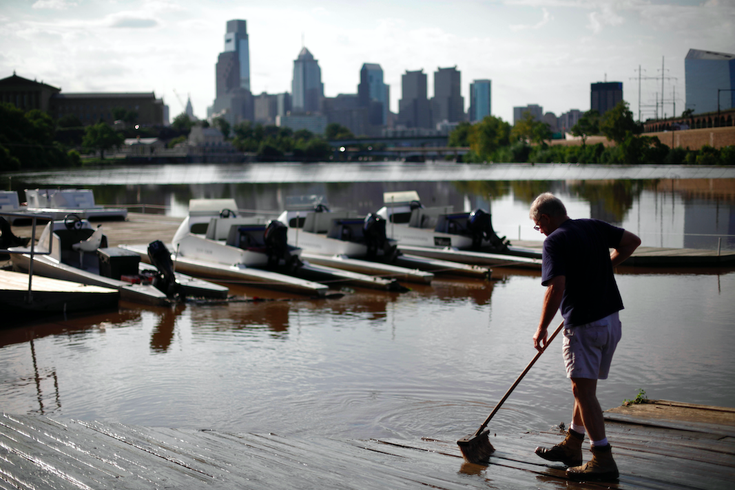
April 25, 2016
 Matt Rourke/AP
Matt Rourke/AP
Jim Lang sweeps silt left behind from floodwaters of the Schuylkill River at the Penn Athletic Club on Boathouse Row in in the aftermath of the storm Irene, Monday, Aug. 29, 2011, in Philadelphia. It was the Schuylkill River that wreaked havoc in the area, cresting to more than 15 feet in Norristown and inundating homes with muddy water and flooding streets in Philadelphia.
Philadelphia will soon become the first major city in the United States to adopt a disaster plan to protect its vast collection of historic buildings, part of a broader Pennsylvania initiative to proactively anticipate the effects of climate change.
The Philadelphia Register of Historic Places currently lists a few thousand historic properties spread throughout the city, including 67 structures — from Center City's Athenaeum to Boathouse Row — that have a place on the National Register of Historic Places. Shielding them from the destruction of natural disasters like Hurricane Katrina or Superstorm Sandy, as PlanPhilly points out, has become a focus of the Philadelphia Office of Emergency Management and the Pennsylvania State Historic Preservation Office (PA SHPO), both partners in the "Disaster Planning for Historic Properties Initiative."
In response to Superstorm Sandy and several other severe weather events, the National Park Service awarded Pennsylvania $1.5 million to help stabilize and repair historic properties in counties across the state. Looking forward, PA SHPO and project teams on the disaster planning initiative will conduct a series of studies to determine needs in Philadelphia and elsewhere:
The goal of these projects will not only be to articulate the problems, but identify solutions that can be applied to various types of geographic locations (i.e., flood plains), hazard scenarios, and historic building types. Goals include: identifying and developing best practices for addressing future disasters to ensure outcomes are the least intrusive for historic properties; employing a variety of techniques for different building types; and considering alternatives for reducing damages from various types of disasters—including, but not limited to, floods, severe wind events, and fires.
According to PlanPhilly, a preliminary assessment of threatened areas in Philadelphia found 505 historic buildings in flood hazard zones that could be impacted by a Category 1 hurricane. Half of them are in Center City and the bulk of the others are located in Manayunk and the Navy Yard.
The initiative to protect historic buildings follows on Philadelphia's first climate readiness adaptation report, published late last year, which breaks down how various risk factors can be addressed by city agencies through early implementation plans.
Philadelphia has received $200,000 from the state for the historic building initiative and will soon conduct a series of hazard mitigation studies to determine the best protection methods for various locations and structures.